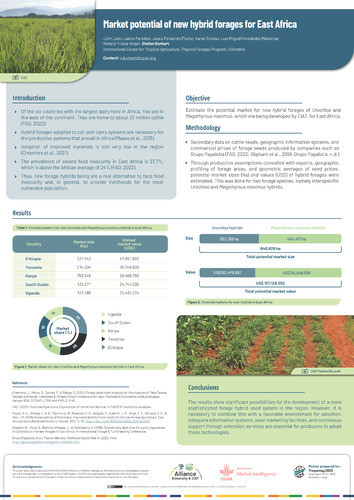Market potential of new hybrid forages for East Africa
Dairy production is the main livestock activity in East Africa and provides food security and income to the poorest families in the region. Especially in the drier areas of East Africa, however, the availability of space for dairy farming is limited, leading to pressure for finding alternatives that help maximise its use. Cut-and-carry forages are one such solution, but the commonly used forages in these systems are generally of low quality making it difficult to fully cover the nutritional needs of the animals. Improved forages have shown to be good alternatives for increasing both quantity and quality of feeds in cut-and-carry systems and improving the adaptability to climate change. With the purpose of promoting the sustainability of livestock farming in the region, CIAT has been developing interspecific hybrids of Urochloa, which are on the market since more than a decade, and is also developing hybrids of Megathyrsus maximus adapted to the local productive and environmental conditions. The objective of this document is to estimate the potential markets for new hybrids of these two species in East Africa. With data from secondary sources, GIS studies of geographic environments, seed price databases, and expert consultation, we calculated the size of these potential markets (in ha) and estimated their potential values (in US$). The results indicate a regional market for new interspecific Urochloa hybrids of 352,158 ha with a value of US$ 62,479,997. The main markets are Ethiopia, Tanzania, and Kenya, which make up 83% of the total market. The potential market for Megathyrsus maximus hybrids is 494,471 ha with a value of US$ 94,648,595. South Sudan, Ethiopia and Tanzania hold a share of 71.63% in this market. These figures show significant possibilities for the development of a more sophisticated forage hybrid seed system in the region. However, it is necessary to combine this with a favourable environment for adoption. Adequate information systems, seed marketing facilities, and continuous monitoring by extension services are essential for producers to adopt these technologies.

